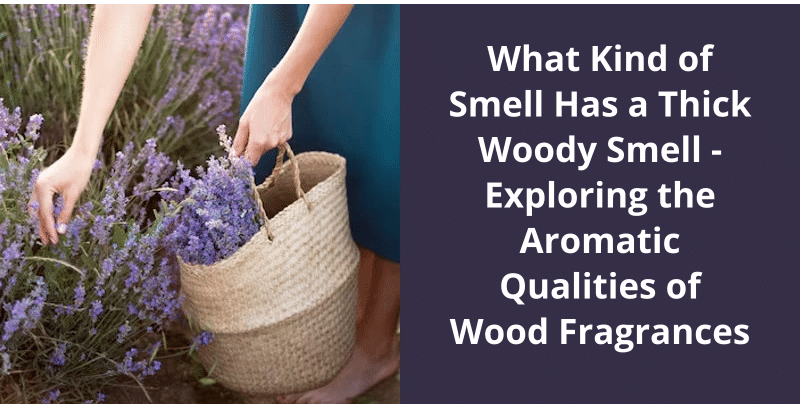A thick woody smell often originates from the scent of various trees and their extracts. These include cedar, agarwood (also known as oud), sandalwood, pine, and oak, each possessing a unique and rich fragrance. For instance, cedar typically has a warm, deep aroma, sandalwood is known for its sweet, soft, and rich smell, while oud is particularly popular for its heavy, intoxicating scent. Combined, these aromas create the earthy, robust, and lingering scent profile that is common to woody fragrances. Moreover, the woody aroma can also include resins, moss, or dried leaves, contributing to the overall picture of a deep forest and the smell one associates with a woods-like environment. It’s worth noting that synthetic notes are also often used in fragrances to emulate these natural aromas.

What Does the Woody Smell Like?
These fragrances are often associated with the outdoors and can instill a sense of warmth, comfort and stability. The woody scent should be rich, warm and soothing, and should create a sense of sophistication. Some of the most popular woody scents include cedar, sandalwood, oakmoss, vetiver, and patchouli amongst others.
It’s warm and comforting aroma promotes a sense of camaraderie and well-being. This woody smell is often used in perfumes and colognes to provide a refreshing and invigorating feel. Another popular scent from woody family is the Sandalwood oil which is commonly used in aromatherapy as it’s a calming effect.
Oakmoss is a common woody scent that’s found in perfumes and colognes. It’s particularly invigorating in combination with citrus and lavender notes. It’s often used in perfumes, colognes, and soaps as it’s a grounding effect on the senses.
Vetiver is a woody and grassy scent that’s become a staple in the world of fragrance. This scent is derived from the vetiver root, and it’s a deep, earthy aroma. It’s complex and rich aroma settles the senses.
Patchouli is a rich and earthy scent derived from the leaves of the patchouli plant. It compliments other essential oils well, and it’s often used in perfumes and colognes as the base note.
The History and Cultural Significance of Woody Scents in Perfume-Making
- The use of woody scents in perfume-making dates back to ancient times.
- Various types of wood, such as sandalwood, cedarwood, and rosewood, have been used to create perfumes with unique olfactory characteristics.
- In some cultures, such as in India, sandalwood is considered a sacred fragrance and is used in religious ceremonies.
- During the Renaissance period, perfumery became a popular art form, and woody scents were often used in high-end perfumes.
- Today, woody scents continue to be a staple in many perfumes and are often used as base notes to provide a long-lasting and complex aroma.
However, in recent years, the question has arisen: are woody scents truly masculine or is it simply a societal construct? While traditionally associated with men’s fragrances, more and more women are embracing, and even creating, wood-based scents. Let’s explore this shift in fragrance preferences and what it means for the industry.
Are Woody Scents Masculine?
However, it’s important to note that woody scents don’t inherently have a gender association. The idea that certain scents are masculine or feminine is a societal construct that’s been perpetuated by marketing campaigns and cultural norms. In fact, wood is a natural material that can be appreciated by anyone, regardless of gender identity.
There are many examples of woody fragrances that are marketed towards women. These perfumes typically balance the wood notes with other ingredients such as floral or fruit accents, creating a more complex and diverse aroma. Additionally, many perfumes are now marketed as unisex or gender-neutral, freeing consumers from traditional gender stereotypes and allowing them to choose scents based on personal preference rather than societal expectations.
It’s also worth noting that personal taste plays a significant role in fragrance choice. Some individuals may prefer sweeter or more floral scents, while others may gravitate towards earthy or musky fragrances. This preference can be influenced by factors such as mood, occasion, and cultural background, among others.
Source: Woody Perfumes For Men For That Sensual Fragrance
Now that we’ve learned about the various scents that fall under the woody fragrance family, it’s important to understand what the term “woody aromatic” means. This term often refers to fragrances that feature a blend of dry, warm, and mossy wood scents with aromatic notes. These aromatic notes may vary from lavender and rosemary to sage and basil, and are typically found in the base notes of the fragrance. Overall, woody aromatic fragrances tend to be sophisticated, earthy, and masculine, making them a popular choice for both men and women.
What Does Woody Aromatic Mean?
One of the most prominent aroma families in the world of perfumery is woody aromatic scents. This category of fragrances is highly versatile and represents a broad range of scents that are often associated with natural elements like forests and mossy trees. Woody aromatic fragrances are typically represented in the base notes and are often recognized by their warm, musky and dry notes that evoke images of woodlands and woody landscapes.
The woody notes can be derived from various sources such as sandalwood, cedar, and woody spices. The aromatic notes usually take the form of herbs, spices and other plant-based ingredients that give the fragrance depth and character.
While woody fragrances can vary in scent, they typically evoke feelings of warmth and comfort. These scents are often associated with masculinity, as they tend to create a lasting impression that’s both sultry and attractive.
By combining woody notes with aromatic ingredients, creators of perfumes and colognes can produce a broad range of unique and complex scents that can evoke feelings of warmth, comfort and serenity.
What Are Some Popular Woody Aromatic Fragrances on the Market?
- Creed Aventus
- Tom Ford Tobacco Vanille
- Guerlain Habit Rouge
- Chanel Egoiste
- Yves Saint Laurent La Nuit de L’Homme
- Dior Fahrenheit
- Bvlgari Man in Black
- Maison Francis Kurkdjian Baccarat Rouge 540
- Amouage Jubilation XXV
- Montale Black Aoud
Now that we’ve explored the various facets of the woody fragrance profile, let’s take a closer look at how this scent can be best described and appreciated. From it’s complex range of warm and resinous notes to it’s drier, more earthy tones, the woodsy scent offers a depth and richness that’s truly unparalleled in the world of fragrance. So, whether you’re a die-hard fan of classic woodsy scents or simply looking to explore a new olfactory world, read on to discover all there’s to know about this captivating fragrance family.
How Would You Describe the Woodsy Scent?
At it’s core, the woodsy scent emulates the great outdoors – the fresh air that wafts through dense, wooded forests. It’s the aroma of the earth itself, of moss covered tree trunks and damp undergrowth thriving underneath the shade of towering trees. This scent profile exudes a rustic charm, evoking nostalgic memories of camping trips, hiking expeditions, and lazy afternoons spent lying on the grassy banks of a tranquil forest stream.
What sets the woodsy scent apart from other fragrance profiles is it’s capacity to transport. A well-composed woodsy fragrance is like a portal to another world, inviting you to take a deep breath and immerse yourself in a sensory journey with every application. It’s no wonder that so many perfumers have embraced the woodsy scent profile, using it as a foundation upon which to build their most captivating and appealing fragrances.
From room diffusers and candles, to skincare and even yoga mats, this fragrance profile has become a staple for those seeking a comforting and rustic scent in their daily lives. It’s no longer confined to the wilderness, but rather has become an all-encompassing lifestyle choice enjoyed by people worldwide.
How Woodsy Scents Are Made: Ingredients and Techniques Used in Perfumery
Woodsy scents in perfumery are made using natural ingredients such as cedar, sandalwood, and patchouli. Synthetic molecules are also used to enhance the fragrance and increase longevity. Techniques such as steam distillation and solvent extraction are used to extract the pure essence of these ingredients which are then blended together to create the final scent.
Conclusion
In conclusion, the world of fragrances is rich and diverse, and woody scents hold a special place in it. So go ahead, indulge in the richness of nature's scents and find your perfect woody companion.





